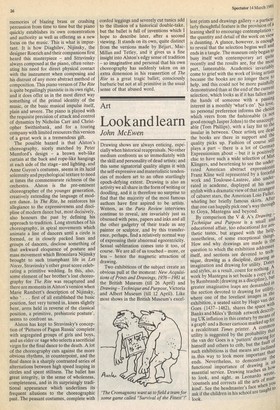Art
Look and learn
John McEwen
Drawing shows are always enticing, espe'cially when historical reappraisals. No other medium confronts us so immediately with the skill and personality of dead artists; and this same signatorial quality aligns it with the self-expressive and materialistic tendencies of modern art to an often startlingly epoch-defying extent. Drawing is also an activity we all share in the form of writing or doodling, and it is therefore no surprise to find that the majority of the most famous authors have first aspired to be artists. Writers, as the Paris Review interviews continue to reveal, are invariably just as obsessed with pens, papers and inks and all the other gadgetry of their trade as any painter or sculptor, and by this transference, perhaps, find a relatively normal way of expressing their abnormal egocentricity. Sexual sublimation comes into it too, of course. We are all of us touched more, or less hence the magnetic attraction of drawing.
Two exhibitions of the subject create an obvious pull at the moment: New Acquisitions of Prints and Drawings, 1976 1981 at the British Museum (till 26 April) and DrawingTechnique and Purpose, Victoria and Albert Museum (till 12 April). Like most shows in the British Museum's excel lent prints and drawings gallery a particularly thoughtful feature is the provision of a leaning shelf to encourage contemplation the quantity and detail of the work on view is daunting. A glance, however, is enough to reveal that the selection begins well and ends in a tangle. The museum only began ro busy itself with contemporary art quite recently and the results are, for the most part, lamentable. Academics invariablY come to grief with the work of living artists because the books are no longer there to help, and this could not be more painfullY demonstrated than at the end of the current selection, which looks as if it has fallen int° the hands of someone with a passing interest in a monthly 'what's on'. No love, no personal preference informs the choice which veers from the fashionable (a not good enough Jasper Johns) to the unaccePt' able (Tom Phillips), with a lazy list to the insular in between. Once artists, are dead the books are there in support and the quality picks up. Fashion of course still plays a part there is a lot of German Expressionism about but it is positivelY chic to have such a wide selection of Max Klingers, and heartening to see the underrated American abstract expressionist Franz Kline well represented by a forceful work and Toulouse-Lautrec, also underrated in academe, displayed at his most stylish with a dramatic view of that strangest of cabaret stars, the American Loie whirling her briefly famous skirts. After that one can happily pick one's way through to Goya, Mantegna and beyond. By comparison the V & A's Drawing Technique and Purpose is a small and educational affair, too educational for aesthetic tastes, but argued with the helP' nonetheless, of some exceptional things. How and why drawings are made is the questiOn to which the exhibition addresses itself, and sections are devoted to tech nique, drawing as a discipline, drawing as imagination and drawing for utility. Dates and styles, as a result, count for nothing. work by Mantegna is set beside a copy of lt, by Rembrandt (drawing as a discipline), nn' greater imaginative leaps are demanded in the section devoted to drawing for utility, where one of the loveliest images in the exhibition, a seated saint by Hugo van der Goes (1437-1482), shares the space with Banks and Miles's 'British artwork descrih ing UK inflation in this century by means of a graph' and a Boxer cartoon marked uP for r a recalcitrant Times printer. A comity') t utility is suggested by the probability rh,...ar the van der Goes is a 'pattern' drawing w, himself and others to crib, but the faufaultsuch exhibitions is that means are incline_ in this way to look more important thau ends. Nevertheless, to demonstrate the functional importance of drawing is essential service. Drawing teaches us IT to look, and sight, as Leonardo -wr°I": 'counsels and corrects all the arts of mafl kind'. See the headmaster's face when Yu_ ask if the children in his school are taught look.






































 Previous page
Previous page